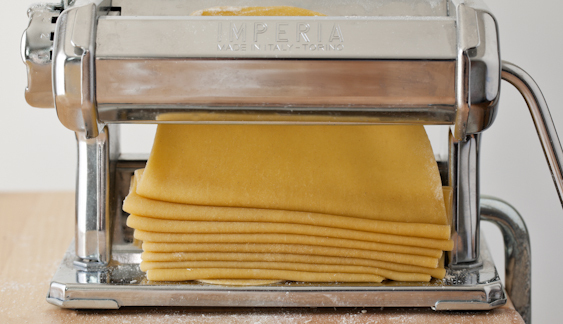Fresh Sheet Pasta

introduction
This pasta, made with Anson Mills Farina di Maccheroni ‘oo’ Crema (Pasta Maker’s Flour), represents the ultimate in production ease and cooperative handling. The strength of Anson Mills Italian heirloom wheat, the oils retained in the flour through fastidious hand-processing, and the recipe formula itself create sheet pasta dough with beautiful extensibility and an absolute disinclination to tear. It rolls see-through thin, if that’s what you want. If left slightly thicker the sheets pick up satisfying heft without losing any delicacy in texture. Wait until you taste this pasta! It has a magnificent mouthfeel, silky texture, and the classic wet al dente snap to the bite, exactly like you find in very best Italian restaurants and trattorias. In short, this flour makes pasta that invoked the term “toothsome.”
To read about our favorite ways to use our fresh sheet pasta, click here.
Cooking Remarks
This is a heavy, rugged dough. It will not feel like a silky, supple noodle dough, and will look pebbly when first processed. Its flawless performance begins at the point when it is run through the pasta machine. It cannot be rolled out by hand.
Properly produced—that is, the ingredients weighed and recipe heeded—this will be a pliant, plasticene dough. It will allow itself to be rolled fine enough to see through. But you may not wish to roll it this finely. The thing about this gorgeous dough is that even when rolled a bit chubbier than paper-thin, it remains tender and delicate when cooked.
This dough must be processed into pasta and cooked expeditiously after its 24-hour rest or it will develop grayish streaks due to oxidation. If it oxidizes, the pasta is nevertheless safe to eat. Its flavor will not be affected.
equipment mise en place
For this recipe, you will need a digital kitchen scale, a food processor, a liquid measuring cup, a small bowl, and a 1-gallon zipper-lock bag.
-
-
10ounces (about 2 cups) Anson Mills Farina di Maccheroni ‘oo’ Crema (Pasta Maker’s Flour), plus additional for dusting the dough
-
½teaspoon fine sea salt
-
2large eggs
-
5large egg yolks
-
0.75ounce (1½ tablespoons) extra-virgin olive oil
-
0.4ounces water
-
-
Place the flour and salt in the bowl of a food processor. Process briefly to combine. Set a liquid measuring cup on a digital kitchen scale and turn on or tare the scale. Crack the whole eggs into the cup. If they weigh more than 3.5 ounces, beat them with a fork and pour or spoon out enough so that they weigh exactly 3.5 ounces. Now, set a small bowl on the scale and add the egg yolks. If they weigh more than 3.2 ounces, beat them, and then spoon out enough so that they weigh exactly 3.2 ounces. Add the yolks to the whole eggs, along with the olive oil and water.
-
With the food processor running, pour the liquid ingredients through the feed tube and process for about 15 seconds. The mixture will form pieces that will chase each other around the bowl and struggle to form a cohesive dough, but, ideally, it will not process into a tidy ball. Instead, the dough will have a broken, curdled look (fig. 2.1). Turn it out onto a work surface and knead it for a couple of minutes without adding flour. It will come together easily under the pressure of your hands and feel smooth but brawny.
-
Return the dough to the food processor and process it for 10 to 15 seconds. Turn the dough back onto the counter and knead without additional flour for 5 minutes. Form the dough into a ball (fig. 3.1), flatten it into a disk, coat it lightly with flour, and place it in a 1-gallon zipper-lock bag. Seal the bag and refrigerate overnight. Roll the dough into pasta and cook the pasta no more than 24 hours after putting the dough into the refrigerator, before it begins to acquire gray streaks from oxidation.
-
-
2.1

-
-
-
3.1

-